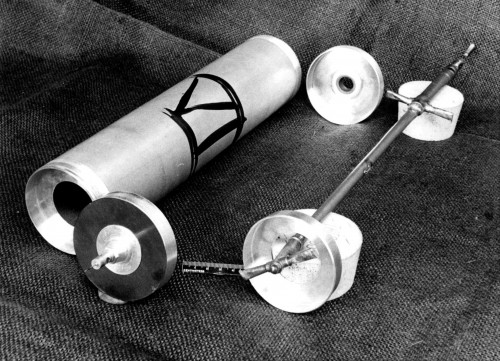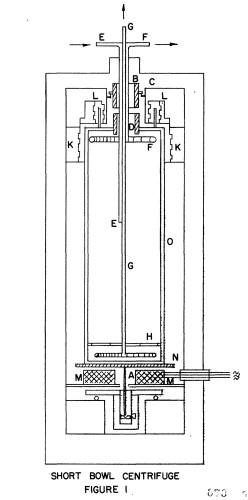R. Scott Kemp, a friend of mine at Princeton’s Science and Global Security program, has just informed me that the latest issue of Technology and Culture has come out with his new article: “The End of Manhattan: How the Gas Centrifuge Changed the Quest for Nuclear Weapons.” 1
It’s a good read and I highly recommend tracking down a copy if you are interested in nuclear history, but especially if you’re interested in the history of proliferation. Scott’s article is the best account I’ve read about how the gas centrifuge went from being a more-or-less abandoned approach to uranium enrichment during World War II to being the proliferation concern of the late-20th and early-21st centuries.
Gas centrifuges had been one of the many types of enrichment technology pursued during the Manhattan Project. Early on, they were heavily favored over the more technically daunting electromagnetic and the totally-untried gaseous diffusion method. Jesse W. Beams at the University of Virginia was the country’s centrifuge expert and he had been looking into using them for isotopic separation as early as 1940. As a result, all of the Manhattan Project centrifuge work was concentrated with him at his laboratory, and in 1941, nearly four times more was allocated to the centrifuge project as was the more speculative gaseous diffusion method.
This is an interesting point to note — we give the Manhattan Project management a lot of credit for trying everything. They spent far more money than a more “optimized” project might have, because they investigated a lot of things that didn’t work out. But despite this approach, they still centralized the work being done on any specific method, usually within a single laboratory, often under the direction of a single scientific luminiary. So Ernest Lawrence was the don of the electromagnetic method; Arthur Compton oversaw reactor research; Harold Urey ran diffusion; and so on. Which seems like a great idea on the face of it. But what if the person you chose just didn’t take the research in the right directions? What if, within that short timescale, they just didn’t hit upon the right answer?
Such was the case with Beams, in Kemp’s assessment: Beams just didn’t figure out how to get centrifuges to work sufficiently well enough. As a result, the Manhattan Project folks proclaimed centrifuges a dead end and dropped the approach in 1944. After the war, there was little US interest in centrifuges — it didn’t seem like they were very workable, certainly not compared to gaseous diffusion. And since gaseous diffusion worked fine for them, they didn’t look too far afield. The lesson of the war, as the US saw it, was that centrifuges weren’t worth the effort.
But in Europe and the USSR, though, work on centrifuges continued. Scott’s account goes into this in some wonderfully wonky technical detail. The end result is that Gernot Zippe, an Austrian physicist, who in the early 1950s figured out (with others) how to fix the problems that Beams had with his centrifuges. Amazingly, he did this while being a prisoner of war in the Soviet Union.
The Zippe centrifuges weren’t anything magical. There was no “secret,” per se, and they didn’t involved any special materials. They just involved working out a few engineering details that made the devices reliable and stable. The major new features introduced by another Austrian POW, Max Steenbeck, and implemented by Zippe were:
- “a ‘point’ bearing that allowed the centrifuge rotor to spin on the tip of a needle (like a toy top) with almost no friction.”
- “the application of loose bearings and weak damping, which allowed the centrifuge to adjust itself so that it spun quietly on its center-of-mass axis without vibration instead of trying to force the axis of rotation”
- “to drive the rotation using electromagnetic fields, just as the armature of an electric motor drives its internal rotating shaft”
That’s it. In engineering terms, these are clever, but hardly revolutionary. These three relatively simply engineering changes “solved essentially all the mechanical problems that had plagued Manhattan Project centrifuges,” Scott writes. In fact, he argues:
It wasn’t that the centrifuge wasn’t possible in the World War II period — it’s just that Beams never figured it out. Scott notes:
The flawed centrifuge was made viable by the application of engineering solutions that were mostly invented around the turn of the twentieth century and all of which predated the Manhattan Project—evidence that the latter’s centrifuge program was frustrated not by the limitations of manufacturing or the technology of the day, but rather by a preliminary design that was never developed to its fullest possible extent.
So the gas centrifuge was really completely viable as early as World War II, but the Manhattan Project scientists just couldn’t get it to work. I thought that was a pretty bold conclusion, one that goes in the face of the standard “superiority myth” that pervades the Manhattan Project work.
Things get really interesting, though, after Zippe et al. figure out how to make it work. Zippe and his colleagues actually convinced the Soviets to let him out early (and to pay him!) if he helped them commercialize centrifuges in Europe. (I think we can file this under “cool things that can happen once Stalin buys the farm.”) Zippe and his colleagues were released from the USSR in 1956, and he went to East Germany. From there, though, he made his way west, and became a centrifuge evangelical — he wanted to commercialize them.
He went around Europe and the United States showing folks how to make efficient gas centrifuges. In 1958 and 1959 he spent time at the University of Virginia (Beams’ home turf) showing them how it was done. Amazingly, this work seems to have been unclassified — you can find the progress reports, featuring the diagrams and photographs I’ve used in his article, on the Department of Energy’s Information Bridge. 2
In 1960, the US realized that the centrifuge was actually going to be a proliferation issue, and started trying to classify the technology again. The problem was, of course, that all of the key developments were produced by non-Americans not in the United States. So in effect the US was saying that nobody in the United States was going to be allowed to work on this without a security clearance, while scientists in Europe could pursue it with a freer hand.
The result of all of this Atoms-for-Peace (Atoms-for-Cash?) enthusiasm with regards to gas centrifuges is that the technology is pretty well dispersed. Scott concludes that:
Today, at least twenty countries have built or acquired centrifuge technology, and the history lesson drawn here suggests that it is within the capability of nearly any state to do so.
As Scott (and Alex Glaser and Houston Wood) have argued elsewhere in another great article, 3 all of this should put to rest any idea that technical solutions alone can limit future nuclear proliferation — we live in a definitely post-Manhattan Project world, and this stuff just isn’t rocket science anymore.
- R. Scott Kemp, “The End of Manhattan: How the Gas Centrifuge Changed the Quest for Nuclear Weapons,” Technology and Culture 53, no. 2 (June 2012), 272-305.[↩]
- The photograph of the centrifuge is from Gernot Zippe, “A Progress Report: The Development of Short Bowl Ultracentrifuges,” UVA/ORL-2400-59 (1 July 1959); the diagram is from Gernot Zippe, J.W. Beams, and A.R. Kuhlthau, “The Development of Short Bowl Ultracentrifuges,” UVA/ORL-2400-58. Scott’s article brought both of these reports to my awareness.[↩]
- Houston G. Wood, Alexander Glaser, and R. Scott Kemp, “The gas centrifuge and nuclear weapons proliferation,” Physics Today 61, no. 9 (September 2008), 40-45.[↩]




[…] Monday I wrote a bit about the history of the Zippe-type gas centrifuge. What’s fascinating about the Zippe centrifuges, for me, is that they were pushed […]
[…] round off this week of centrifuges, I thought we might actually look at a few of them. Photographs of real-life […]
The 1960 timing of the renewed US interest in centrifuge secrecy and proliferation is an interesting one. Before the U-2 incident ended the Geneva process for the time being, the US was focused on increasing its nuclear detection capabilities to potentially verify what eventually became the Limited Test Ban Treaty and the French just began their own testing.
US nuclear intelligence efforts prior to the test ban moratorium that began in late 1958 was focused on detection of nuclear explosions. However, there was always a component of identifying fissile material production facilities. Those that produced plutonium were detectable by sampling the atmospheric load of krypton-85, which is produced in proportion to the amount of plutonium produced from uranium in production reactors like those at Hanford and Savannah River. Since Pu-239 made for much more efficient use of feed and fissile materials, the assumption was that a focus on it would give a good estimate of Soviet plutonium production. It did, with estimates by the early 1950s that were considered to be accurate to within 5%. The application of this model to other nations proved problematic, as these reflections on centrifuge history demonstrate.
The issue with uranium — and the use of centrifuges to produce it — is that this fissile materiel production method was much more difficult to detect at long range due to the lack of any marker isotope comparable to Kr-85. Sure, building U-235 weapons could make for much less efficient use of fissile material, but if you’re a state that just needs a few weapons and a single confirmed nuclear explosion to prove your point (like North Korea), that may not matter.
One can use imagery to search for large new facilities or monitor the distribution of power needed to drive such a centrifuge facility. Neither are as definitive as Kr-85, as there could be looms just as easily as centrifuges in any particular building, although one would guess that a fabric plant will likely have nowhere near the security in place as a nuclear facility. So centrifuges present both a proliferation problem and an intelligence problem. Whether this was one of these reasons behind the renewed US interest in limiting centrifuge technology in 1960 is hard to say, but it certainly was and is a complicating factor in terms of general concerns about keeping track of who has the ability to get their hands on fissile material.
That’s an interesting perspective, Mike, thanks.
This brought to mind an interesting article from Studies in Intelligence: Henry S. Lowenhaupt, “The Decryption of a Picture.” The short version is that a Soviet magazine published a photo of the inside of an electrical station near Sverdlovsk, and over the course of several months the CIA was able to figure out how a certain switching board corresponded with known electricity uses and plants, and eventually found that an inordinate amount of electricity was going somewhere that wasn’t known to them, and this allowed them to find a previously-unknown gaseous diffusion plant.
But I agree that this was obviously a much more difficult signal to track, in and of itself, than sampling the air.
[…] wrote about centrifuges a few weeks ago, and have learned some new, interesting things since then. John Krige, a professor […]
[…] discussed Kemp’s article on the development of the centrifuge here. […]
I am currently writing a novel about the Iranian nuclear centrifuges in Chalus. Do you have any information on the latest types of centrifuges used? German manufactures or any info on Zippe-type centrifuges or the IR-1 or IR-2m. Thanks
Just finished reading Kemp’s paper, and I have to give him credit for the section heading “Not Ready for Прайм-Тайм.” I laughed out loud when I saw that.